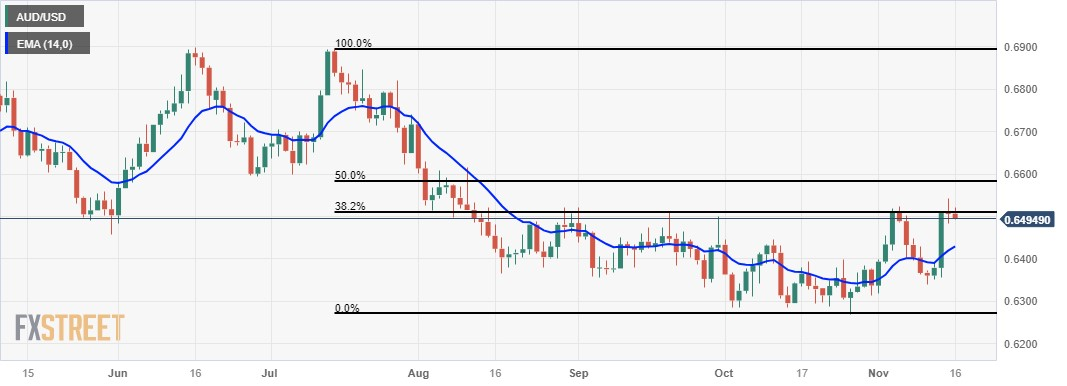- Australian Dollar snaps a winning streak despite a solid increase in new jobs in the country.
- Australia’s Employment Change increased to 55K in October; the Unemployment Rate rose by 3.7% as expected.
- US PPI unexpectedly declined by 0.5% compared to the expected increase of 0.1%.
- China’s House Price Index declined by 0.38% in October, indicating a worsening condition in the property sector.
The Australian Dollar (AUD) moves below the 0.6500 psychological level with a negative bias on Thursday after the release of the Australian Employment data. The seasonally adjusted Employment Change reported an increase of 55K in October, compared with the market anticipation of 20K and 6.7K in the previous month. However, the majority of the jobs were part-time positions, which somewhat diminished the positive impact of the overall headline.
Australia’s Unemployment Rate came in at 3.7% in October as expected against the previous figure of 3.6%. However, the AUD/USD pair experienced volatility in the previous session after the economic data was released from the United States (US) on Wednesday.
China’s House Price Index declined by 0.38% in October compared to the previous decline of 0.1%, indicating a worsening condition in the country's property sector.
The four-hour talks between US President Joe Biden and Chinese President Xi Jinping have resulted in a commitment to stabilize strained bilateral ties and restore some military-to-military communications. This commitment signals an effort to address and improve the complex relationship between the two nations, potentially paving the way for better diplomatic and strategic cooperation in the future.
The reported comments from China’s President Xi Jinping, as conveyed by Xinhua, emphasize the hope for a partnership between China and the United States. The key points include a call for mutual respect, peaceful coexistence, and cooperation in various fields such as the economy, trade, agriculture, climate change, and artificial intelligence.
President Xi also expressed the desire for the US to cease arming Taiwan and to support what China terms as the 'peaceful reunification' with Taiwan. Additionally, there is a request for the US to lift unilateral sanctions and create a fair and just environment for Chinese companies.
US Producer Price Index (PPI) took an unexpected turn in October, declining by 0.5% against the anticipated 0.1% increase. The annual rate also witnessed a drop from 2.2% to 1.3%. These figures align with the softer inflation indicated by Tuesday's US Consumer Price Index (CPI) data.
The report from the US Bureau of Labor Statistics indicated a more significant slowdown in US inflation than originally anticipated. This unexpected deceleration triggered a notable decline in the US Dollar (USD) value.
Adding to the economic landscape, US Retail Sales declined by 0.1% in October, defying expectations of a steeper slide of 0.3%. Investors' focus shifts to weekly Jobless Claims on Thursday.
Daily Digest Market Movers: Australian Dollar weakens amid mixed Aussie jobs data
- Australia’s Wage Price Index grew 1.3% as expected compared to the previous reading of 0.8%. The year-over-year data showed an increase of 4.0% more than the anticipated 3.9%.
- Australia’s Westpac Consumer Confidence declined by 2.6% in November, swinging from the previous growth of 2.9%.
- RBA Assistant Governor (Economic) Marion Kohler stated that the decline in inflation is expected to be slower than initially anticipated. This is attributed to the persistent high level of domestic demand and robust pressures from labor and other costs. Kohler emphasized the need for a tighter policy to address the challenges posed by elevated inflation.
- Economists at the National Australia Bank (NAB) anticipate another 25 basis points hike in February following the Q4 inflation data. Additionally, NAB believes rate cuts will unlikely commence until November 2024.
- China's Industrial Production (YoY) showed growth at 4.6% in October, a slight increase from the previous 4.5%, contrary to expectations of consistency. Retail Sales year-over-year saw an uptick to 7.6%, surpassing the anticipated 7.0%.
- The US Consumer Price Index (CPI) for October showed lower readings than expected, with the annual rate slowing from 3.7% to 3.2%, falling below the consensus forecast of 3.3%. The monthly CPI reduced to 0.0% from 0.4%.
- The US Core CPI rose by 0.2% below the expectations of 0.3%, and the annual rate decreased to 4.0% from 4.1% prior.
- US Monthly Budget Statement reported a deficit of $67B in October, compared to the expected deficit of $65B.
Technical Analysis: Australian Dollar remains below the 0.6500 major level lined up with the 38.2% Fibonacci retracement
The Australian Dollar trades around the 0.6490 level on Thursday, in line with immediate resistance at the psychological level of 0.6500. The next resistance levels include the 38.2% Fibonacci retracement at 0.6508 and the 50% retracement at 0.6582. On the downside, the AUD/USD pair may find support at the 14-day Exponential Moving Average (EMA) at 0.6429, followed by the major support level at 0.6400.
AUD/USD: Daily Chart
Australian Dollar price today
The table below shows the percentage change of Australian Dollar (AUD) against listed major currencies today. Australian Dollar was the weakest against the US Dollar.
| USD | EUR | GBP | CAD | AUD | JPY | NZD | CHF | |
| USD | 0.10% | 0.32% | 0.13% | 0.45% | 0.08% | 0.72% | 0.12% | |
| EUR | -0.10% | 0.22% | 0.04% | 0.34% | -0.03% | 0.61% | -0.01% | |
| GBP | -0.33% | -0.22% | -0.17% | 0.12% | -0.25% | 0.41% | -0.22% | |
| CAD | -0.13% | 0.00% | 0.18% | 0.29% | -0.05% | 0.59% | -0.02% | |
| AUD | -0.44% | -0.35% | -0.13% | -0.31% | -0.37% | 0.27% | -0.34% | |
| JPY | -0.07% | 0.03% | 0.24% | 0.08% | 0.38% | 0.64% | 0.04% | |
| NZD | -0.72% | -0.62% | -0.40% | -0.56% | -0.28% | -0.65% | -0.61% | |
| CHF | -0.11% | -0.01% | 0.22% | 0.05% | 0.34% | -0.03% | 0.61% |
The heat map shows percentage changes of major currencies against each other. The base currency is picked from the left column, while the quote currency is picked from the top row. For example, if you pick the Euro from the left column and move along the horizontal line to the Japanese Yen, the percentage change displayed in the box will represent EUR (base)/JPY (quote).
Australian Dollar FAQs
What key factors drive the Australian Dollar?
One of the most significant factors for the Australian Dollar (AUD) is the level of interest rates set by the Reserve Bank of Australia (RBA). Because Australia is a resource-rich country another key driver is the price of its biggest export, Iron Ore. The health of the Chinese economy, its largest trading partner, is a factor, as well as inflation in Australia, its growth rate and Trade Balance. Market sentiment – whether investors are taking on more risky assets (risk-on) or seeking safe-havens (risk-off) – is also a factor, with risk-on positive for AUD.
How do the decisions of the Reserve Bank of Australia impact the Australian Dollar?
The Reserve Bank of Australia (RBA) influences the Australian Dollar (AUD) by setting the level of interest rates that Australian banks can lend to each other. This influences the level of interest rates in the economy as a whole. The main goal of the RBA is to maintain a stable inflation rate of 2-3% by adjusting interest rates up or down. Relatively high interest rates compared to other major central banks support the AUD, and the opposite for relatively low. The RBA can also use quantitative easing and tightening to influence credit conditions, with the former AUD-negative and the latter AUD-positive.
How does the health of the Chinese Economy impact the Australian Dollar?
China is Australia’s largest trading partner so the health of the Chinese economy is a major influence on the value of the Australian Dollar (AUD). When the Chinese economy is doing well it purchases more raw materials, goods and services from Australia, lifting demand for the AUD, and pushing up its value. The opposite is the case when the Chinese economy is not growing as fast as expected. Positive or negative surprises in Chinese growth data, therefore, often have a direct impact on the Australian Dollar and its pairs.
How does the price of Iron Ore impact the Australian Dollar?
Iron Ore is Australia’s largest export, accounting for $118 billion a year according to data from 2021, with China as its primary destination. The price of Iron Ore, therefore, can be a driver of the Australian Dollar. Generally, if the price of Iron Ore rises, AUD also goes up, as aggregate demand for the currency increases. The opposite is the case if the price of Iron Ore falls. Higher Iron Ore prices also tend to result in a greater likelihood of a positive Trade Balance for Australia, which is also positive of the AUD.
How does the Trade Balance impact the Australian Dollar?
The Trade Balance, which is the difference between what a country earns from its exports versus what it pays for its imports, is another factor that can influence the value of the Australian Dollar. If Australia produces highly sought after exports, then its currency will gain in value purely from the surplus demand created from foreign buyers seeking to purchase its exports versus what it spends to purchase imports. Therefore, a positive net Trade Balance strengthens the AUD, with the opposite effect if the Trade Balance is negative.
Information on these pages contains forward-looking statements that involve risks and uncertainties. Markets and instruments profiled on this page are for informational purposes only and should not in any way come across as a recommendation to buy or sell in these assets. You should do your own thorough research before making any investment decisions. FXStreet does not in any way guarantee that this information is free from mistakes, errors, or material misstatements. It also does not guarantee that this information is of a timely nature. Investing in Open Markets involves a great deal of risk, including the loss of all or a portion of your investment, as well as emotional distress. All risks, losses and costs associated with investing, including total loss of principal, are your responsibility. The views and opinions expressed in this article are those of the authors and do not necessarily reflect the official policy or position of FXStreet nor its advertisers. The author will not be held responsible for information that is found at the end of links posted on this page.
If not otherwise explicitly mentioned in the body of the article, at the time of writing, the author has no position in any stock mentioned in this article and no business relationship with any company mentioned. The author has not received compensation for writing this article, other than from FXStreet.
FXStreet and the author do not provide personalized recommendations. The author makes no representations as to the accuracy, completeness, or suitability of this information. FXStreet and the author will not be liable for any errors, omissions or any losses, injuries or damages arising from this information and its display or use. Errors and omissions excepted.
The author and FXStreet are not registered investment advisors and nothing in this article is intended to be investment advice.
Recommended content
Editors’ Picks

EUR/USD holds losses below 1.1400 ahead of ECB policy decision
EUR/USD stays on the back foot below 1.1400 in the European session on Thursday. The pair loses ground on the back of a broad US Dollar rebound and as traders remain cautious ahead of the European Central Bank interest rate decision and Lagarde's press conference.

GBP/USD stays defensive near 1.3250 as US Dollar bounces
GBP/USD stays defensive near 1.3250 in Thursday's European trading, snapping its seven-day winning streak. A tepid US Dollar recovery amid risk appetite prompts the pair to pullback from six-month highs of 1.3292 set on Wednesday. Traders look to tariff headlibnes and US data for fresh impetus.

Gold price retreats from record high as profit-taking kicks in
Gold price retreats after touching a fresh all-time peak earlier this Thursday and erodes a part of the previous day's blowout rally though the downside remains cushioned. A slight improvement in the global risk sentiment, bolstered by hopes of US trade negotiations, turns out to be a key factor undermining the precious metal.

European Central Bank set to cut interest rates again amid easing inflation and tariff uncertainty
The European Central Bank will announce its April interest rate decision on Thursday at 12:15 GMT. Markets widely expect the central bank to lower key rates for the sixth consecutive time. This time the ECB is set to deliver another 25 basis points (bps) cut after the April policy meeting.

Future-proofing portfolios: A playbook for tariff and recession risks
It does seem like we will be talking tariffs for a while. And if tariffs stay — in some shape or form — even after negotiations, we’ll likely be talking about recession too. Higher input costs, persistent inflation, and tighter monetary policy are already weighing on global growth.

The Best brokers to trade EUR/USD
SPONSORED Discover the top brokers for trading EUR/USD in 2025. Our list features brokers with competitive spreads, fast execution, and powerful platforms. Whether you're a beginner or an expert, find the right partner to navigate the dynamic Forex market.




